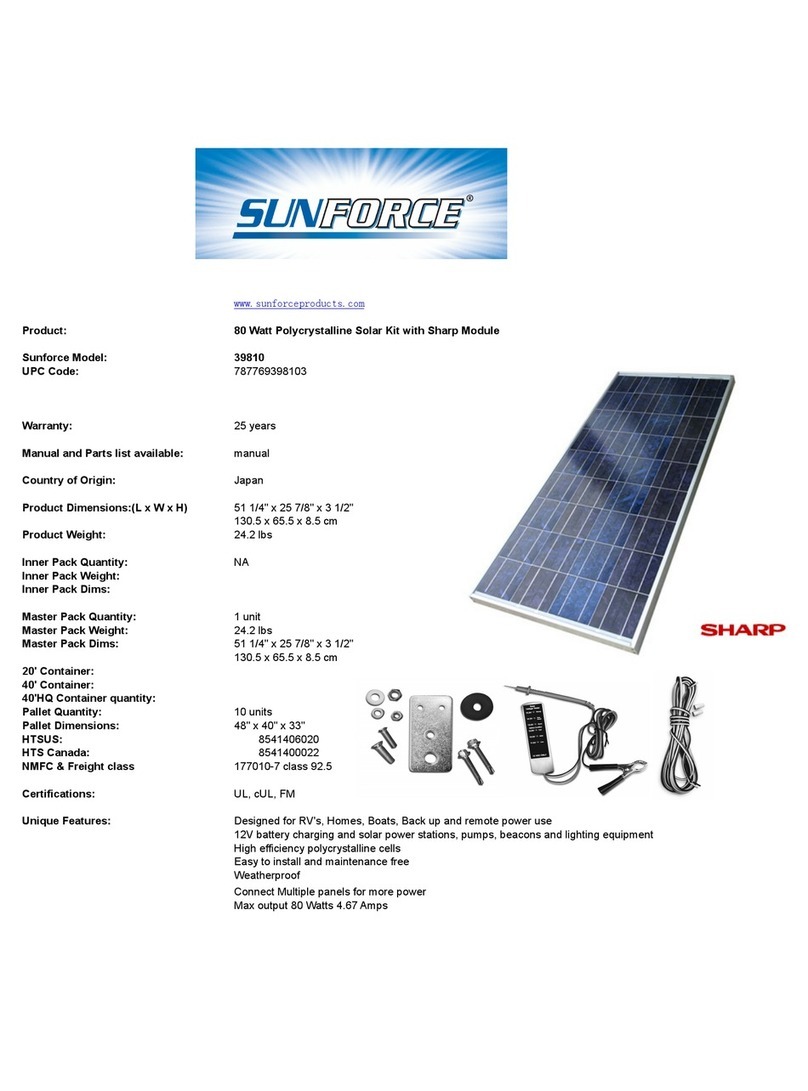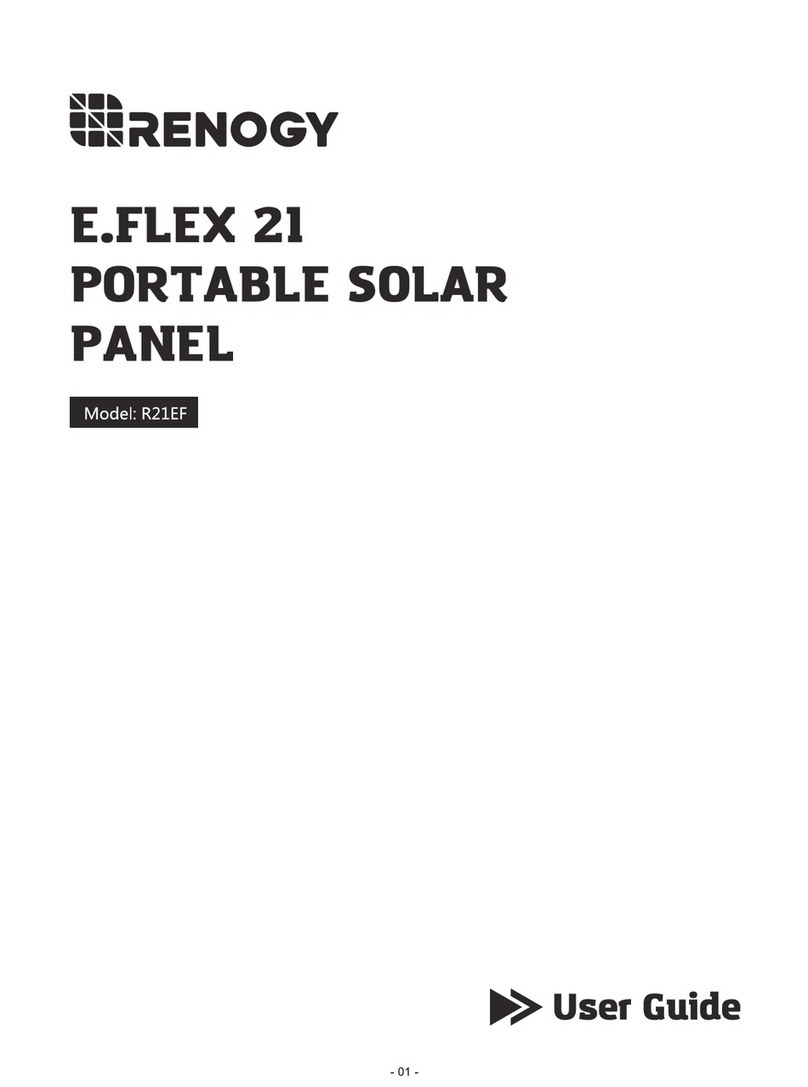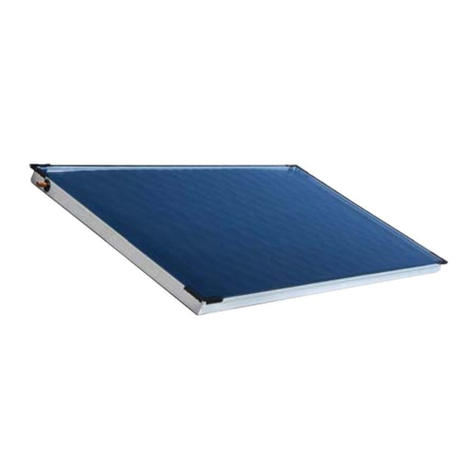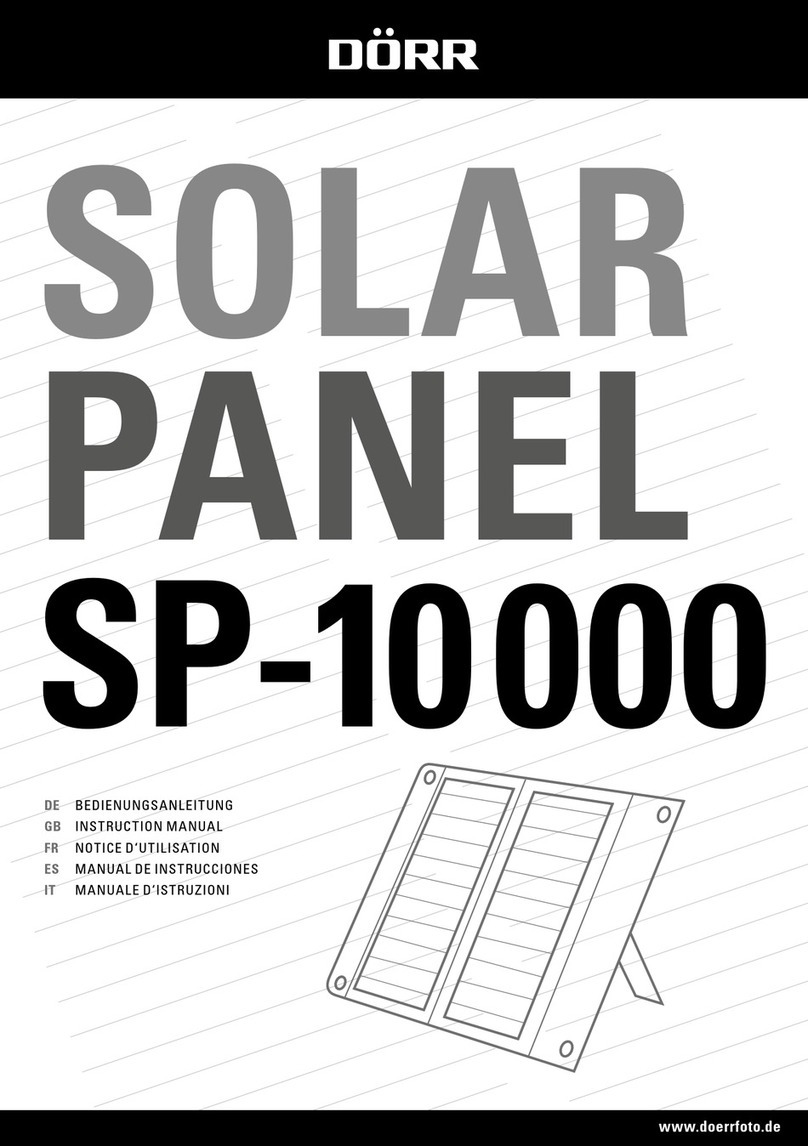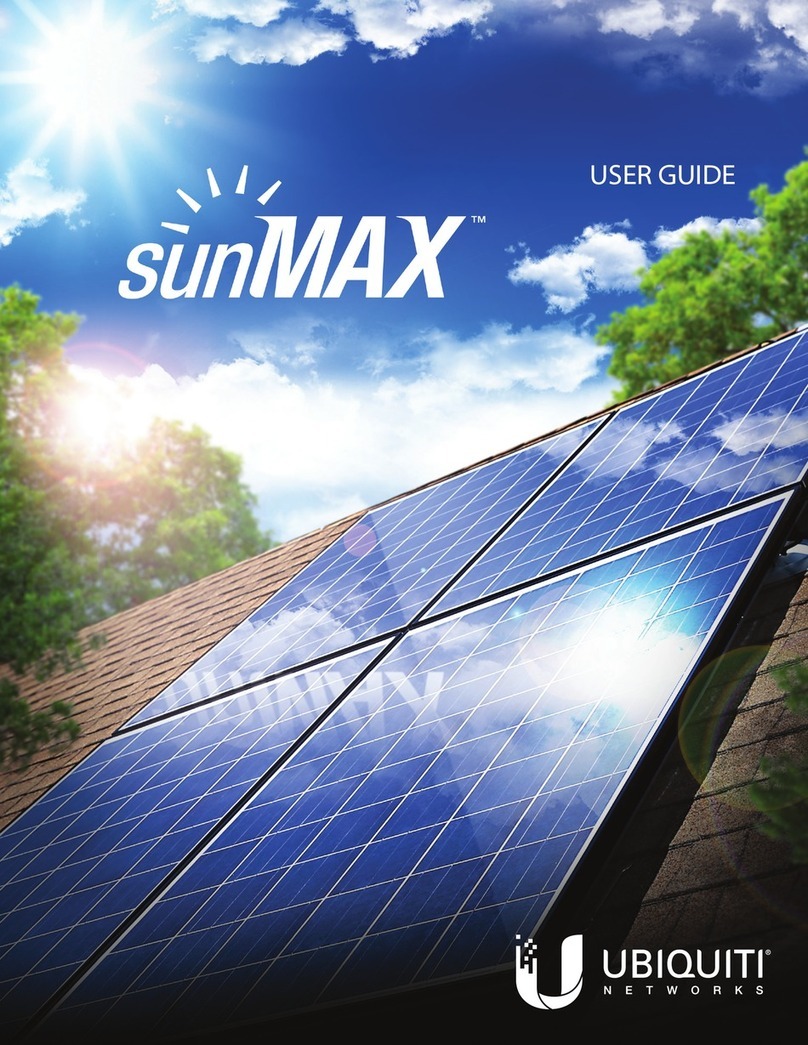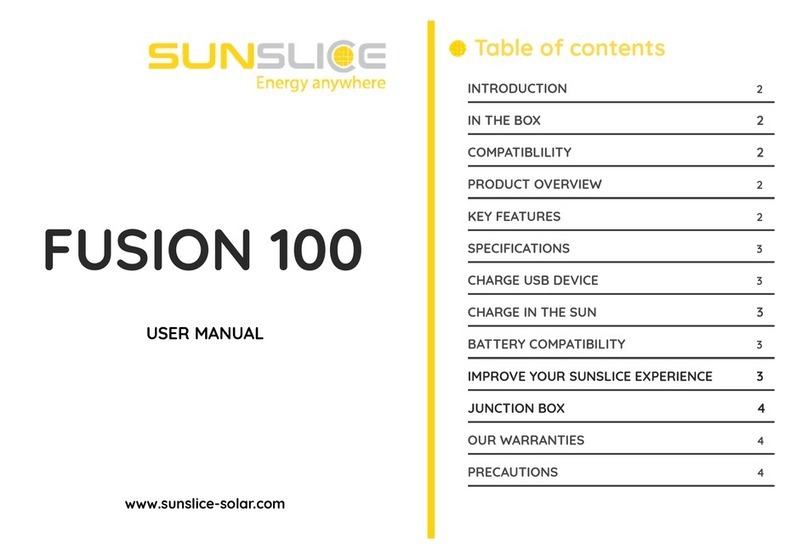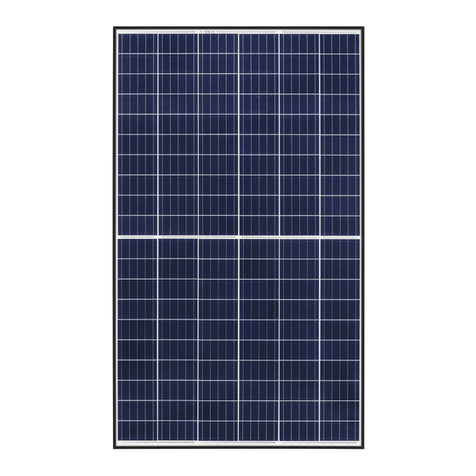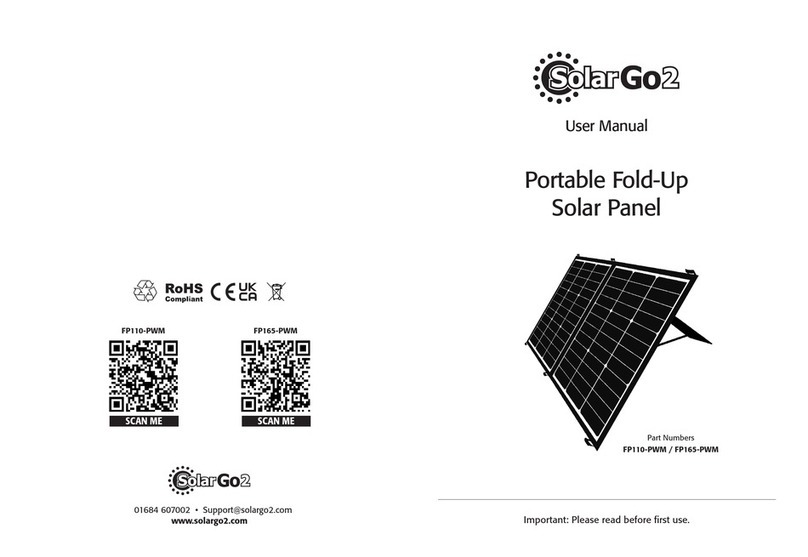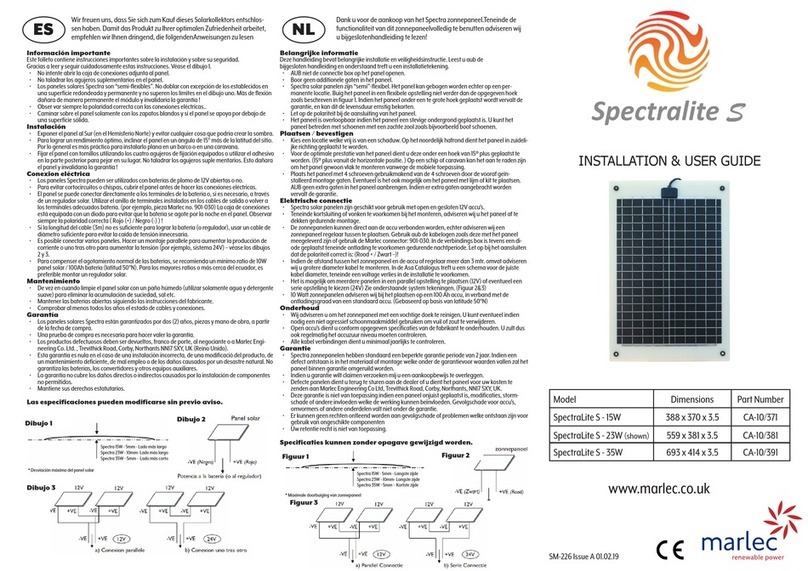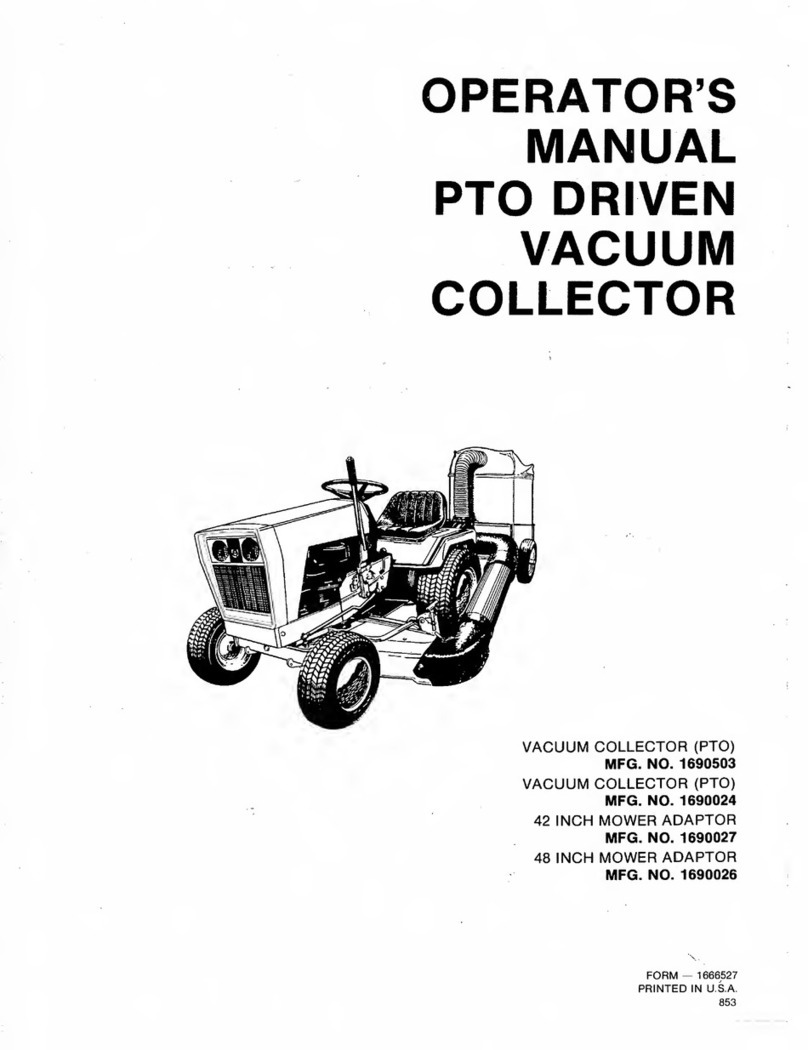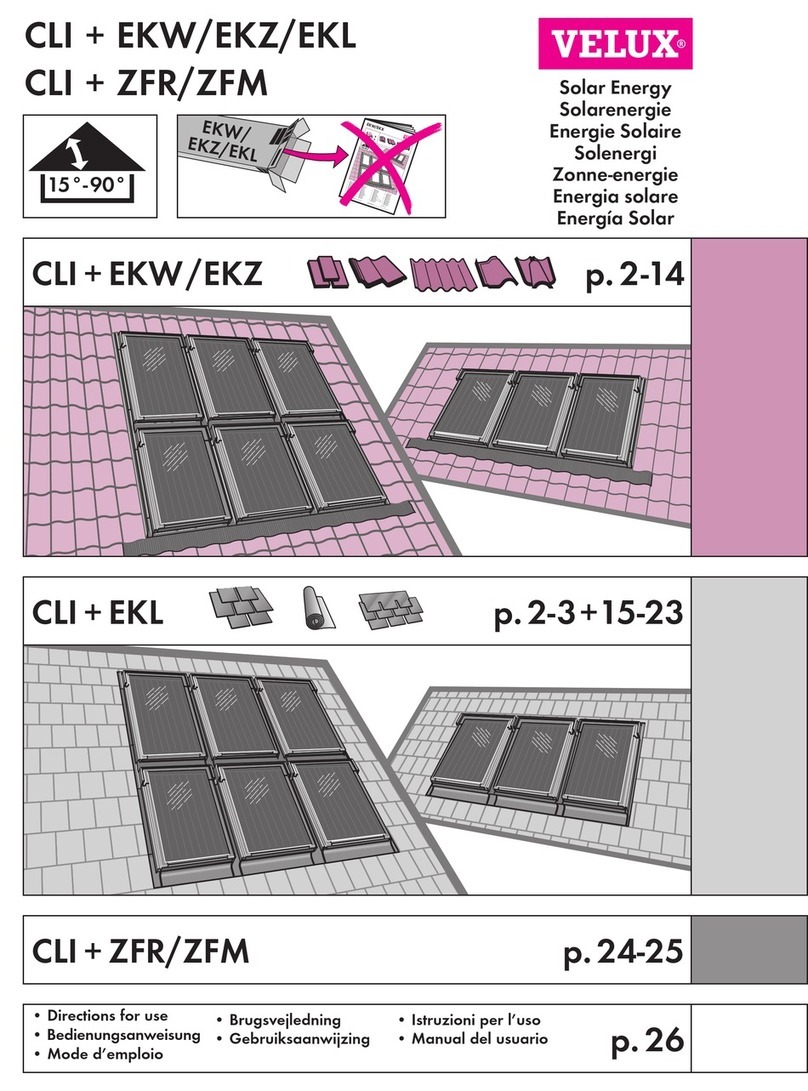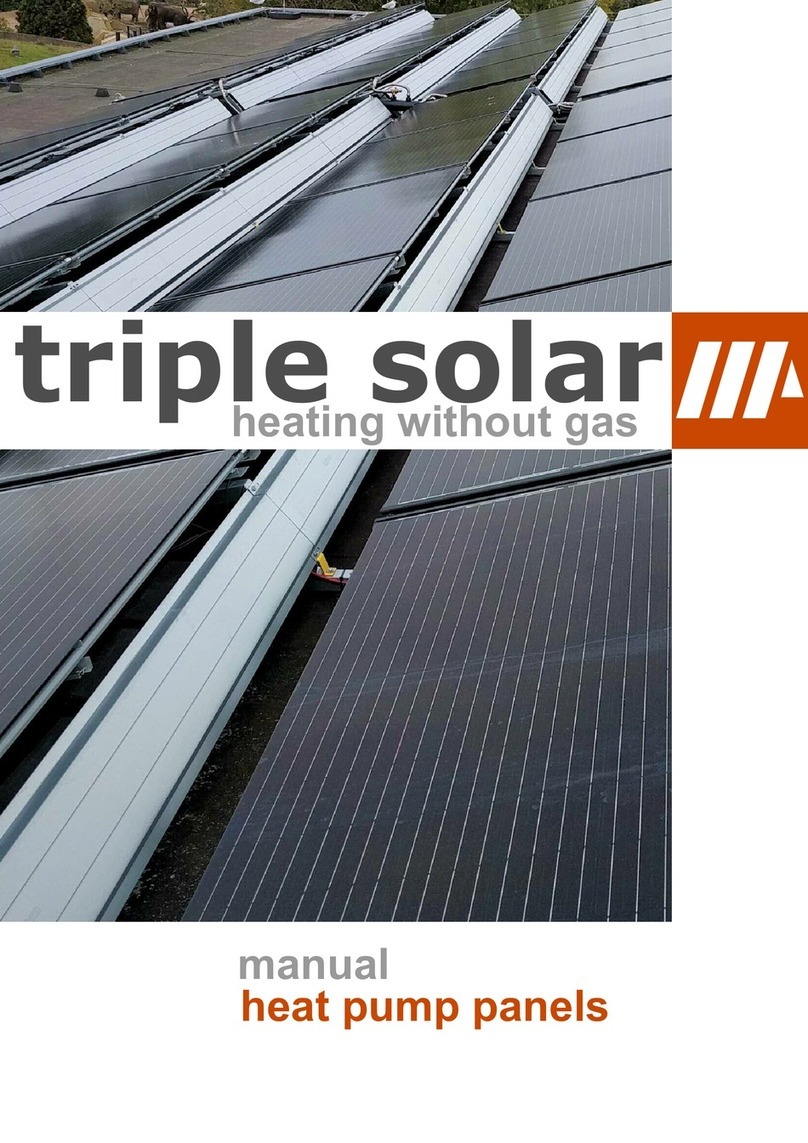Global Solar powerflex User manual

Global Solar Energy recommends having the
PowerFLEX™ MOBILE Solar Kit professionally installed.
Although the kit is relatively straightforward to install,
working with high current battery systems and working
on the roof of the RV can be dangerous.
Global Solar Energy will be happy to work directly with
your dealer or service center of choice to ensure a
proper, long lasting installation. Just send us their
contact information or have them contact us and we’ll
take care of the rest.
GSE Document: 1000564 Rev. E

PowerFLEX
TM
MOBILE
Solar Power for Your RV
READ THIS PRIOR TO INSTALLING
The PowerFLEXTM MOBILE Solar Charging Kit is intended for use on newer roofs
that are in good condition when using only the adhesive to secure the solar panel
to the roof.
Cleaning the roof is critical in obtaining a safe, secure and long-lasting
installation. Failure to follow the included instructions can result in loss of
adhesion, damage or loss of the product, and shortened product life.
Mechanical fasteners such as screws or rivets are recommended in any
installation where the quality of the roof is questionable or if the vehicle is to be
used in extreme environments.
Contact Global Solar Energy Technical Support if you have any questions,
concerns or would like to discuss you special application.
GSE Document: 1000564 Rev. E

PowerFLEXTM MOBILE
Installation Instructions
Solar Power for Your RV
Global Solar Energy, Inc.
8500 S. Rita Road
Tucson, AZ 85747
Technical Support
www.GlobalSolar.com
520-546-6313
DOCUMENT NO. 1000564 REV. E
www.GlobalSolar.com
1

2
Contents:
INTRODUCTION & SAFETY INFORMATION.......................................................................................................3
KIT CONTENTS..................................................................................................................................................4
TOOLS REQUIRED FOR INSTALLATION.............................................................................................................4
OTHER ITEMS ...................................................................................................................................................4
STORAGE & HANDLING PRECAUTIONS............................................................................................................5
INSTALLATION OVERVIEW ...............................................................................................................................5
SOLAR PANEL LOCATON...................................................................................................................................6
ROOF SURFACE PREPARATION ........................................................................................................................6
INSTALLING THE SOLAR PANELS ......................................................................................................................8
INSTALLING THE EDGE TRIM............................................................................................................................9
SPECIAL ROOF TYPES......................................................................................................................................12
LOCATING THE SOLAR CHARGE CONTROLLER...............................................................................................12
ROUTING THE CABLE......................................................................................................................................13
CONNECTING THE WIRING ............................................................................................................................17
MAINTENANCE...............................................................................................................................................18
APPENDIX.......................................................................................................................................................20
Technical Support.......................................................................................................................................20
About The Solar Charge Controller............................................................................................................20
Charge Controller Specications: ...............................................................................................................21
Solar Panel Specications:.........................................................................................................................21
Installaon Summary Chart .......................................................................................................................22
WARRANTY REGISTRATION...............................................................................................................................................19
DOCUMENT NO. 1000564 REV. E
Global Solar® PowerFLEX™ Mobile Limited Warranty................................................................................ 23

3
INTRODUCTION & SAFETY INFORMATION
The PowerFLEXTM MOBILE Kit product line, the premier solar solution for RV’s , has been
specically developed for use on recreational vehicles and will provide years of reliable service
when properly installed.
IMPORTANT
READ THESE INSTRUCTIONS COMPLETELY BEFORE BEGINNING INSTALLATION
FAILURE TO FOLLOW THESE INSTRUCTIONS CAN RESULT IN DAMAGED PRODUCT, DAMAGE TO THE RV, AND/OR
PERSONAL INJURY
GLOBAL SOLAR ENERGYHIGHLY RECOMMENDS HAVING THIS SYSTEM INSTALLED BY A PROFESSIONAL RV
TECHNICIAN
THE INSTALLER SHOULD BE FAMILIAR WITH:
DC electrical systems and wiring in RVs
Working with high capacity battery systems
ADDITIONAL PRECAUTIONS
NEVER MIX SOLAR PANELS OF DIFFERING BRANDS, PART NUMBERS OR POWER RATINGS IN THE SAME SYSTEM.
DOING SO WILL RESULT IN POOR PERFORMANCE AND MAY DAMAGE COMPONENTS
WORKING WITH ELECTRICITY AND LEAD ACID BATTERIES CAN BE DANGEROUS
INSTALLATION OF THE SOLAR PANELS REQUIRES WORKING ON THE ROOF OF THE RV WHERE THERE IS A RISK OF
FALLING
WARNING!
SOLAR PANELS PRODUCE ELECTRICITY WHEN EXPOSED TO LIGHT
EVEN WHEN NOT CONNECTED TO THE SYSTEM. THE SOLAR PANELS
SHOULD BE COVERED WHENEVER WORKING ON THE SOLAR POWER
SYSTEM IN ORDER TO AVOID ELECTRICAL SHOCK AND/OR ARCING.
DOCUMENT NO. 1000564 REV. E

4
KIT CONTENTS
Your PowerFLEXTM MOBILE Solar Power Kit includes the following items:
ITEM PFM-2K PFM-1K PFM-1E
PowerFLEX Solar Panel 2 1 1
Solar Charge Controller Kit
1. Charge Controller, 1ea.
2. StandoffBlocks, 2ea.
3. Ring Terminals, 2ea.
4. #6 x 1” Screws, 2ea.
5. #6 x 2” Screws, 2ea.
1 1 -
Edge Trim Set (7 pieces)
2
1
1
Top right, top le, boom, (4) sides
Structural Adhesive Caulking 300 ml-310 ml 1 1 1
Cable with PV connector (1 Pos, 1 Neg) 20’ 20’ 0
Cable, 10 AWG/2-Conductor 20’ 20’ 0
Y-Connector Set (1 Pos, 1 Neg) 1 0 1
Inline ATC Fuse Holder w/20A Fuses
2
2
-
Ring Terminal, 10 AWG (Large)
2
2
-
Cable Tie Mounts
10
4
10
Cable Ties 14 6 14
TOOLS REQUIRED FOR INSTALLATION
Safety glasses suitable for use around liquid chemicals
Phillips screw driver
Wire cuers and strippers
Caulking gun
Crimping tool for 10 AWG connectors (ratcheng type preferred)
Ulity knife
OTHER ITEMS
Roof cleaning supplies appropriate for roof type
Medium Synthec Bristle Brush (E.g. deck scrub brush)
Mild Liquid Dish Soap or RV-dealer-recommended wash
Warm Water
Isopropyl Alcohol >70%
DOCUMENT NO. 1000564 REV. E

5
Pressure Washer / Hose With Spray Nozzle
Tape measure
STORAGE & HANDLING PRECAUTIONS
Failure to follow these Storage and Handling guidelines can lead to product damage and premature failure
and violate the PowerFLEXTM MOBILE Limited Warranty.
For the protecon of PowerFLEXTM MOBILE kits, the kit contents and sealed boxes must always be
stored between temperatures of 60°F (15°C) and 85°F (30°C).
Do not use screws, nails, staples or otherwise puncture any part of the solar panel.
The PowerFLEXTM solar panel must not be rolled to a diameter smaller than 20”. Doing so may
result in permanent internal damage and lead to immediate or premature failure. Do not fold or
crease the solar panel.
Scratches on the panel surface can occur if walked on improperly. Guidelines to avoid such
damage include:
oKeep walking on the solar panel to an absolute minimum.
oDo not walk on the solar panel with hard soled shoes.
oInspect shoe tread for rocks or debris before stepping on the panel.
oBe careful not to drop objects on the solar panel.
The solar panel surface is slippery. Use extreme cauon.
Do not aempt to open the solar panel’s juncon box. The juncon box contains no user
serviceable parts.
Do not aempt to open the solar charge controller. The controller contains no user serviceable
parts.
The solar panel can become very hot when le in direct Sun light. Gloves may be required in
hoer climates.
INSTALLATION OVERVIEW
The installaon of the PowerFLEXTM MOBILE solar kit is fairly simple and straight forward with a lile
planning. The key installaon steps are:
1. Choose a suitable locaon for the solar panel(s).
2. Prepare roof surface.
3. Install the solar panels, edge adhesive, and edge trim.
4. Choose the internal RV locaon for the charge controller.
5. Route the cable from the solar panels to the charge controller and then to the baeries.
6. Connect the wiring.
DOCUMENT NO. 1000564 REV. E

6
SOLAR PANEL LOCATON
The following recommendaons for locaon of the PowerFLEXTM solar panels are important to ensure
best performance and aesthecs. The PowerFLEXTM solar panels:
Need to be placed close enough to each other so that the pre-fabricated cables will reach. The
included “Y” cables in the two panel system will allow the panels to be placed 6’-7’ apart.
Route the cables such that they are not pulling or placing stress on the panel’s juncon box.
Bends or turns in the wiring should be gentle and as large as possible.
Can be posioned either in-line with the RV or across it.
Should be located in an area that is not shaded by the AC unit, satellite or TV antenna, roof vents,
etc…
Require a minimum of 21.5” x 81.5” area, including edging.
Note: It is a good idea to “dry fit” the solar panels and edge trim components prior to permanently
adhering them to the roof.
ROOF SURFACE PREPARATION
PROPER ROOF PREPARATIONIS PARAMOUNT TO ATTAIN THE NECESSARY LONG-TERM
ADHESION OF THE PANEL AND MOUNTING STRUCTURE
Follow all recommendaons in this secon for Roof Preparaon and associated precauons
Addional Precauons and Warnings
New EPDM roofing surfaces may contain a layer of mica or other nonsck layer. This layer must
be removed.
Citrus based cleaners, denatured alcohol, or mineral spirits are not recommended for use on
EPDM rubber roofing materials.
All roofing surfaces can be very slippery when wet. Extreme cauon should be taken and it is
recommended to navigate the roofing surface on your hands and knees. This will greatly reduce
the risk of falling.
Note: For older rubber (EPDM) roofs, the solar panels should be adhered to the roof with screws
as described in “SPECIAL ROOF TYPES” secon.
DOCUMENT NO. 1000564 REV. E

7
Direcons forRoof Preparaon
A. Use a pressure washer or a hose witha spray nozzle toremove loose dirt and debris from the
enre roof.
B. Combine your mild liquid dish soap soluon with warm water in a bucket or spray bole.
a. A 20:1 rao of warm water and mild liquid dish soap cleaner should be sufficient for new
roofing surfaces (about 6oz of soap per gallon of water). Using cold or tepid water is not
recommended as this will reduce the strength of the adhesive bond.
b. Alwaysconsult withthe RV manufacturer for opmal cleaning methods.
C. Using a medium bristle brush and the cleaning soluon begin scrubbing the roofing surface in
small areas that are easily reachable on your hands and knees(E.g. arm’s length or 3’ X 3’ areas).
a. Beginning at one end of the roof and working toward the point of exit on the roof where
the solar panels will be placed.
b. Be sure toalso prepare the areas where the cable e mounts will be placed [See secon
for ROUTING THE CABLE].
D. Scrub the roofing surface ina circular moon applying a moderate amount of pressure unl any
visible evidence of dirt and debris is removed. Oen, aer surface dirt is removed, a light yellow
surface coloraon is observable. If such a yellow surface is visible, repeat the scrubbing step unl
the yellow disappears, leaving a clean white colored surface.
E. Rinse the roof with water thoroughly toavoid any residue buildup.
F. For EPDM roofs, wipe the area where the PowerFLEXTM panels will be adhered with Isopropyl
Alcohol.
G. Inthe case of Gel-coated Fiberglass roofs, the isopropyl alcohol wipe is not required. However, a
final surface wax removal step is required with an appropriate wax-remover or acetone is
required. All the other surface preparaon steps are idencal toEPDM roofs.
DOCUMENT NO. 1000564 REV. E

8
INSTALLING THE SOLAR PANELS
WARNING!
SOLAR PANELS PRODUCE ELECTRICITY WHEN EXPOSED TO LIGHT
EVEN WHEN NOT CONNECTED TO THE SYSTEM. THE SOLAR PANELS
SHOULD BE COVERED WHENEVER WORKING ON THE SOLAR POWER
SYSTEM IN ORDER TO AVOID ELECTRICAL SHOCK AND/OR ARCING.
A. The PowerFLEXTM solar panels included a long piece of cardboard in the package. This piece of
cardboard should be cut to the length of the solar panel and used to shade it during the
installaon. Use tape to hold the cardboard in place.
B. Start by aligning the solar panel to the posion chosen when locang the panels. As shown below,
roll back one end of the panel about 2 feet and remove 10”-12” of the protecve paper liner to
expose the adhesive. Lay the panel back down and apply pressure to bond to the roof surface.
C. Next, as shown below, go to the other end of the panel and roll it back towards the end already
adhered. Pull the protecve paper liner offslowly in 2 foot increments, applying pressure
starng from the center and working towards the outer edges unl the enre panel is affixed to
the roof.
DOCUMENT NO. 1000564 REV. E
DOCUMENT NO. 1000564 REV. E

9
INSTALLING THE EDGE TRIM
Suggested Sequence
The installaon of edging framework is a 3 step process
1. Ensure all parts fit together well around the panel.
2. In the recommended sequence (labeled above), one edge at a me, apply the liquid
adhesive to the panel edge using a caulking gun, and then adhere the edge pieces to the
panel edge.
3. Repeat above step for the remaining 3 panel edges, in the recommended sequence.
1. Ensure Proper Fit
A. Lay the 7 rubber edge trim pieces around the perimeter of the PowerFLEXTM panel.
B. Starng at the end opposite the cables [labeled “1” above], carefully place the trim piece
so that the inner edge of edge trim piece is centered and bued against the edge of the
panel.
C. Next, align and place the two trim pieces at the wiring end of the panel [labeled “2”
above] in the same manner, making sure the trim parts fit properly against the edge of
the panel.
D. Place a long, side trim piece [labeled “3” and ”4” above] so that there is a 1/8” gap
between it and the end trim that has already been placed. Repeat for the remaining
pieces of side trim [labeled “5” and “6” above. A gap where the two side pieces meet in
the center is normal.
1
2
3
4
5
6
DOCUMENT NO. 1000564 REV. E

10
1
Trim at boom of panel
2
Trim at top of panel
3-6
Trim at corners with 1/8” gap
All edge trim in place
2. Procedure for mounng-edge aachment to edge of panel
A. Prepare the p of the adhesive tube by cung the p at a 45°angle. The opening should
be approximately 3/16” in diameter. Prepare and use the adhesive as described here.
DOCUMENT NO. 1000564 REV. E

11
B. Starng with the edge trim piece labeled in the sketch above as #1,
i. Apply the liquid adhesive to the panel edge, leaving a bead approximately 3/16”
wide. The trim piece must be placed within 10 minutes of dispensing the
adhesive.
Adhesive bead along the edge of the solar panel (Normally transparent; Shown as black for clarity)
Proper fit of edge trim to solar panel
ii.For the associated edge trim piece, remove the protecve liner to expose the
adhesive.
iii.Adhere the edge trim piece to the panel edge by carefully placing it so that the
inner edge of edge trim piece is gently bued against the edge of the panel like
was done in the trail run.
iv. Apply even pressure to ensure edge trim piece is uniformly secured
v. Repeat above process for panel edge #2 using the 2 separate edging pieces.
Apply a 3/16” wide bead of adhesive to the boom surface of the edge trim
piece that extends over the panel.
Solar Panel
Edge Trim
EternaBond
Tape
EternaBond
Tape
Liquid
Adhesive
DOCUMENT NO. 1000564 REV. E

12
C. Repeat above process for panel edge #3 and#4, being sure to
i. Buthe edge of each piece against the already-placed pieces AND
ii.Ensure that the outer edge of the new piece matches the outer edge of the
exisng piece [See above sketch].
3. The system should be allowed to cure a minimum of one hour prior to moving the vehicle. It may
be driven aer six hours but, will not be fully cured unl 24 hours.
SPECIALROOF TYPES
RVs with older rubber rooops may not be able to achieve sufficient bonding using only the
adhesive due to “chalking” or severe oxidaon.
oIn these cases, it is recommended that screws be used to secure the rubber edge trim
components to the roof, especially on the upwind edge of the panel.
oThe edge trim parts are marked with a small dimple indicang where screws should be
placed. Using these pre-marked locaons will ensure that the screw will not go through
the solar panel.
oUse #8 x 1” stainless steel pan or truss head sheet metal screws.
RVs constructed with a metal skin, such as most Airstream travel trailers, should use pop rivets or
through-bolts in addion to the adhesive mounng system. These fasteners must be located in
the pre-marked dimples on the rubber edge trim components to avoid damaging the panel.
LOCATING THE SOLAR CHARGE CONTROLLER
The solar charge controller is designed to be flush mounted in an interior wall of the RV. Choose a
locaon that is convenient for roung the cable and for viewing. Flush mounng the controller will
require cung a hole in the wall or cabinet that is 4-11/16” wide by 3-11/16” tall.
DOCUMENT NO. 1000564 REV. E

DOCUMENT NO. 1000564 REV. E
13
ROUTING THE CABLE
The overall circuit is generally as follows
Your PowerFLEXTM MOBILE kit came with 20’ lengths of 10 AWG solar cable with connectors to
the panels and a 20’ length of 10 AWG / 2-conductor cable to link the controller to the baery.
These lengths should be sufficient for most installaons. If more cable is required, use wire that is
the same conductor size or larger. Using a smaller wire size can result in performance losses and
potenally create a fire hazard. See the following wire-sizing table for further informaon.

DOCUMENT NO. 1000564 REV. E
14
Wire Size (AWG) for <7% Voltage Drop
Current (A)
(# PFM Panels)
Distance (FT)
10 15 20 25 30 35 40 45 50 55 60
6 (1) 12 12 12 12 12 12 12 12 12 10 10
12 (2) 12 12 12 12 10 10 10 8 8 8 8
18 (3) 12 12 10 10 8 8 8 6 6 6 6
24 (4)
12
10
10
8
8
6
6
6
6
4
4
30 (5)
10
10
8
8
6
6
6
4
4
4
4
36 (6)
10
8
8
6
6
4
4
4
4
3
3
Note: 90°C, Copper Conductor
When roung the cable, leave a foot or so extra at each end to make connecons easier.
In most cases, the refrigerator vent is the best place to route the cable from the roof into the RV.
Some RVs have the refrigerator located in a slide-out. In this case, an alternate locaon will be
required and may require creang a roof or front cap penetraon. This should be performed by a
professional RV technician to ensure a waterght seal.
Starng at the solar panel connecons, plan the roung for the Y-cables and connecon cables
[see below] across the roof to the entry locaon. Use the provided cable e mounts and cable
es to secure the cable to the roof. Be sure to prepare the roof surface in the same manner as
already described for ensuring good panel and edging adhesion prior to scking down the cable
e mounts.
oA cable e mount must be placed directly adjacent to each side of each pair of cable
connectors, at the center of each “Y” cable (where the three cables join in the middle)
and then at least every 4’ along the roof to the point of entry. Use addional mounts
anywhere the cable is not well supported. Addional cable e mounts can be purchased
at your local hardware store if needed.

DOCUMENT NO. 1000564 REV. E
15
Cable tie mounts must be applied in the following manner to ensure proper adhesion:
Insert the supplied cable e into the
cable e mount.
Apply the supplied adhesive to the
boom of the cable e mount and affix
to the locaon where you will be roung
the cabling.
Adjust the cable e so the connector of
cable eprotrudes 1” from the center of
the cable e mount.
Allow the adhesive to cure for 1-hour
before securing the PV cables with the
cable e mounts.

DOCUMENT NO. 1000564 REV. E
16
Connue roung the cable to the solar charge controller locaon and cut to the appropriate
length. Mark the Posive (+) cable prior to cung. Remember to leave some extra cable to make
the final connecons easier.
At the charge controller end of the PV cable, strip 3/8” of insulaon to expose the copper wire.
Next, cut the loop on one of the included ATC inline fuse holders and strip 3/8” of insulaon from
each end. Be sure a fuse is NOT in the holder. The fuse will be inserted in a later step. Crimp a
splice connector to one end of the fuse wire and one of the small ring terminals to the other. Do
not use the large ring terminal at this step. Crimp the other end of the splice connector to the
posive (+) wire. Crimp another small ring terminal to the negave end of the cable. Do not
connect the cable to the charge controller yet. This will be done in a later step.
Route the 10AWG, 2-conductor cable from the charge controller to the baery locaon. Strip the
cable as above at the charge controller end and crimp small ring terminal to each wire. Do not
connect the cable to the charge controller yet.
At the baery locaon, cut the cable from the charge controller to the desired length. Remove
approximately 12” of the outer jacket of the 10AWG, 2-conductor cable. Strip the wire ends as
above and aach the other inline fuse holder to the posive wire. Make sure a fuse is NOT in the
fuse holder. Crimp a large ring terminal to the other end of the fuse holder and to the negave
wire. WARNING - Do not locate the inline fuse holder elsewhere on the cable. For safest
installaon it must be located at the baery.

DOCUMENT NO. 1000564 REV. E
17
CONNECTING THE WIRING
Prior to connecng any of the wires, be sure the fuses are removed from the fuse holders and the solar
panels are covered.
WARNING – RISK OF EXPLOSIVE GASES
Working around lead-acid batteries can be dangerous.
Batteries generate explosive gases during normal battery operation.
Wear complete eye and clothing protecon when working with lead-acid baeries.
Follow all safety and applicaon precauons from the baery supplier.
Always operate the charge controller in an open, well-venlated area.
Never smoke or allow spark or flame in the vicinity of the baery. Lead-acid baeries generate
explosive gases.
Neutralize any acid spills thoroughly with baking soda before aempng to clean up.
Make sure someone is within range of your voice to come to your aid if needed while working
with lead-acid baeries.
Have plenty of fresh water and soap nearby in case baery acid comes in contact with your skin
or clothing. Wash with soap and water immediately and then get medical aenon.
Avoid touching your eyes while working with baeries. Corrosive parcles may get into your
eyes. If this occurs, flush eyes immediately with running water for at least 10 minutes.
Immediately seek medical aenon.
Never aempt to charge a frozen baery.
Remove all personal metal items from your body such as rings, bracelets, necklaces and watches
while working on or around baeries. A baery can produce a short circuit current high enough
to weld a ring (or the like) to metal, causing a severe burn.
Take care not to drop any metal tool or object onto the baery. This may result in a spark or
short circuit across the baery or other electrical device that could cause an explosion.
Note that in the 2-panel configuraon, the panels are connected in parallel (posive-to-posive
and negave-to-negave). Do not connect in series.

DOCUMENT NO. 1000564 REV. E
18
WHEN ALL OTHER INSTALLATION AND SAFETY ITEMS HAVE BEEN COMPLETED
Final connecons should be made in the following order:
1. Ensure that the cardboard covers over the solar panels are sll in place.
2. Select GEL or LEAD ACID baery mode.
3. Connect the posive (+) lead of the solar array to the ARRAY POSITIVE (+) terminal of the charge
controller.
4. Connect the negave (-) lead of the solar array to the ARRAY NEGATIVE (-) terminal of the charge
controller.
5. Connect the posive cable from the baery to the BATTERY POSITIVE (+) terminal of the charge
controller.
6. Connect the negave cable from the baery to the BATTERY NEGATIVE (-) terminal of the charge
controller.
7. Once all of the wiring connecons are complete, insert the provided 20A ATC fuses into the fuse
holders and close the water resistant caps.
8. Next, remove the cardboard covering the solar panels.
9. Check the front panel of the charge controller. Provided there is sufficient Sun light, the
“POWER” and “CHARGING” or “FLOAT” LED lights should be on. If the “PROTECTION” and/or
“BATTERY REVERSE” lights are on, cover the solar panel(s) and check the wiring.
MAINTENANCE
Proper maintenance is important and will ensure years of reliable performance. If your PowerFLEXTM
MOBILE system will be stored in shaded condions for longer than one week, it is recommended that the
PV system fuse nearest to the baery first be removed at the beginning of this storage period and only
while the modules are shaded.
. The solar panel(s) should be checked periodically and before each trip for the following:
In the case that the baery is to be disconnected the PV fuse closest to the baery must first be
removed.
Verify there is good adhesion of each solar panel and edge trim part.
Check that all wiring is secure.
Make sure the solar panels are clean. Excessive dirt or debris will reduce the power output. Bird
droppings are corrosive and should be removed as soon as possible.
Table of contents
